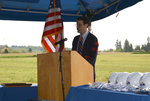

A field in southwest Ridgefield that once grew potatoes will be producing a new kind of “spud” in the coming years.
The planned intermediate school complex for the Ridgefield School District and recreation facility finally broke ground on May 1, though given the speed at which the project went from ballot measure to the start of construction, the progress has been anything but sluggish, according to local officials.
Although the threat of rain made the groundbreaking a soggy affair, a tent set up on the property was packed with both interested community members and Ridgefield School District students there to commemorate the construction of a roughly $100 million capital facilities project.
The project will include a fifth-grade through eighth-grade complex with two distinct schools for fifth through sixth grades and seventh through eighth grades.
What’s more, the project will also include the construction of the Ridgefield Outdoor Recreation Complex, a partnership between the school district and the city of Ridgefield that officials have said will save the district about $5 million total.
The groundbreaking on the first of May was a direct result of a February vote allowing for a roughly $78 million capital facilities bond paid for by district landowners. The vote needed to be a supermajority, and the ballot measure easily passed with close to 69 percent of voters in support.
At the groundbreaking, several speakers from school officials, key players in the bond’s success and even a representative of the ancestral farmland on which the schools would be built addressed those gathered. RSD Superintendent Nathan McCann led the ceremony, mentioning that the buildings were on track to be open for business in fall 2018.
Ridgefield Mayor Ron Onslow also spoke, commenting on just how quickly the project is moving.
“I don’t know of any other situation … in the state you passed a bond and you are going to open up a year later; that’s just almost unheard of,” Onslow said. “The fact that the school board and Nathan (McCann) had the foresight to step forward and say, ‘We are going to put this out to bid before the bond, because we are pretty sure the bond is going to pass,’ and it did with great numbers, it’s just fantastic.”
Ridgefield School District Board of Directors President Scott Gullickson mentioned that the project was the first new school in the district since 1976, and the first new standalone educational facility in nearly half a century.
As to the success of the bond, Gullickson said it came down to the drive of community members, be it those in the Capital Facilities Advisory Committee (CFAC), the advocacy group Citizens for Ridgefield Schools or any others who voices support on getting the buildings built.
“In many cases, strangers became neighbors and neighbors became friends throughout this process,” Gullickson said. “People stood shoulder to shoulder to accomplish one goal by sharing one theme, and that theme simply was ‘failure is not an option.’”
Also speaking were CFAC co-chair Amy Draper, Citizens for Ridgefield Schools co-chair Jim Maul and Union Ridge Elementary third-grade student Liam Schafer.
From spuds to Spudders
Gullickson mentioned that the project was particularly unique as it was the culmination of the vision of a landowner who was born in the Ridgefield community in 1919. Bill Bartel had farmed the land for his entire life, with Gullickson explaining it was Bartel’s desire that the land now owned by the district be used for educational purposes, not new houses or commercial developments.
Representing the Bartel estate was Bill’s son, Pete, who remarked he had taken on a sort of “ghost of Christmas past” role at the ceremony before revealing his class of 1971 Ridgefield High School sweater.
Pete Bartel gave a history about the farm that stretched back to his grandfather, Henry Bartel, an immigrant of German descent who came to the area around the turn of the 20th century. He talked about his father, Bill, who along with his five siblings had to make a 4-mile round-trip trek to the two-room Lambert School for the eight years he went.
“Although my dad had one of the highest scores in the state on the eighth-grade examination and loved learning, his parents said he didn’t need any more education just to plod behind a couple of plow horses,” Pete Bartel said.
Though his father was not able to go on to high school, Pete mentioned that all three of Bill’s children went on to college, and of eight grandchildren who graduated from RHS, three were valedictorians and all went onto receive degrees “thanks to the foundation they received in the Ridgefield schools.”
Bill Bartel eventually decided to sell 50 acres of the farm in 2004 with the idea to build a high school on the land. Though the planned complex is for younger grades, the project is planned to increase the district’s capacity by close to 60 percent, benefitting district students regardless of how the final plan played out.
Pete Bartel mentioned some of what his family grew on the land, including hay, oats, strawberries, “and what else?” he asked before pulling out a few potatoes. A history of potato farming in the region led to the RHS mascot known as the “spudder.” Although not known for being particularly formidable in a competition as other mascots based on warriors or fierce animals, the spud holds a connection to history within the rapidly-growing community.
“Although this ground no longer grows spuds, it will continue to grow Spudders,” Pete Bartel remarked.